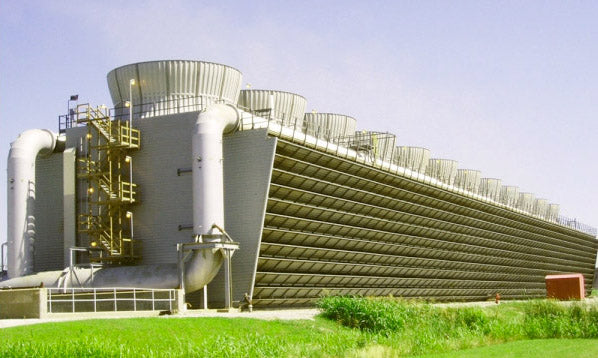Optimizing Cooling Tower Performance: Understanding Efficiency, Maintenance, and Water Quality Management
February 28, 2024 0 Comments

Leveraging the Lakewood 3175 controller for managing the conductivity of water in cooling towers presents a significant advancement in operational efficiency, chemical usage optimization, and mitigating corrosion and deposition. This intelligent controller is designed to automate the process of maintaining water quality, directly impacting the cooling tower's performance and longevity.
Enhancing Operational Efficiency
The Lakewood 3175 controller's primary function is to regulate the conductivity levels in the cooling tower water. By precisely controlling the conductivity, the system ensures that water is used efficiently, reducing the need for excessive blowdown. Blowdown, the process of removing water with high concentrations of dissolved solids, is essential for preventing scale and maintaining efficient heat transfer. Automated control means the system operates at optimal efficiency, constantly adjusting to real-time conditions. This automation reduces the manual intervention required, allowing for more consistent and reliable operation.
Scenario: A cooling tower operates at a flow rate of 1,000 gallons per minute (gpm) and traditionally performs manual blowdown based on a fixed schedule, leading to excessive water waste and inconsistent conductivity levels.
With Lakewood 3175: The controller automates blowdown based on real-time conductivity measurements. If the ideal conductivity level is maintained at 3,000 µS/cm (microSiemens per centimeter), but manual operations often fluctuate between 2,500 µS/cm to 3,500 µS/cm, the precision of the Lakewood 3175 can maintain conductivity at ±100 µS/cm of the target level.
Calculation: By optimizing blowdown, let's say the system reduces water discharge from 5% to 3% of the total flow rate.
- Traditional Method: 1,000 gpm x 5% = 50 gpm of water wasted
- With Lakewood 3175: 1,000 gpm x 3% = 30 gpm of water wasted
This represents a 40% reduction in water wastage, significantly enhancing operational efficiency and conserving water resources.
Reducing Chemical Consumption
One of the most significant advantages of using the Lakewood 3175 is its impact on chemical consumption. By maintaining the conductivity within a specific range, the controller minimizes the overuse of chemicals that are typically required to treat the water. Chemical treatments are necessary to prevent corrosion, scale, and biological growth within the cooling tower. However, overuse of these chemicals not only increases operational costs but also poses environmental concerns. The Lakewood 3175 ensures that only the necessary amount of chemicals is used, promoting both economic and environmental sustainability.
Scenario: Assume a cooling tower requires a chemical dosing of 10 ppm (parts per million) based on the water volume to prevent scale and corrosion. However, due to manual oversight, the actual dosing fluctuates between 8 ppm to 12 ppm.
With Lakewood 3175: The controller's precise conductivity control enables more consistent water quality, allowing for an optimized and stable chemical dosing at exactly 10 ppm.
Calculation: For a cooling tower with a water volume of 100,000 gallons:
- Overdosing (Traditional): 100,000 gallons x 12 ppm = 1,200 pounds of chemicals
- Optimal Dosing (With Lakewood 3175): 100,000 gallons x 10 ppm = 1,000 pounds of chemicals
This equates to a 16.7% reduction in chemical usage, lowering operational costs and minimizing environmental impact.

Mitigating Corrosion and Deposition
Corrosion and deposition are two major challenges in cooling tower operation. Corrosion can lead to the deterioration of metal parts, while deposition (scale and sediment build-up) can severely impact the heat transfer efficiency and overall operation of the cooling tower. The Lakewood 3175 controller plays a crucial role in mitigating these issues. By keeping the water conductivity at ideal levels, the system prevents the conditions that lead to corrosion and scale formation. This not only extends the life of the cooling tower components but also maintains the system's efficiency and effectiveness.
Scenario: A cooling tower without precise conductivity control faces accelerated corrosion rates, leading to equipment replacement every 5 years. Deposition reduces efficiency, increasing energy consumption by 10%.
With Lakewood 3175: Improved water quality control reduces corrosion rates, extending equipment life to 7 years. Efficiency losses due to deposition are cut in half, to a 5% increase in energy consumption.
Calculation:
- Corrosion Impact: Extending equipment life from 5 to 7 years represents a 40% increase in lifespan.
- Energy Consumption: Reducing the efficiency loss from 10% to 5% directly decreases energy costs associated with operating the cooling tower's fans and pumps.
This example illustrates the tangible benefits of implementing the Lakewood 3175 controller in a cooling tower system. By maintaining optimal conductivity levels, the system not only conserves water and reduces chemical usage but also extends the life of the cooling tower infrastructure and improves overall operational efficiency. These benefits underscore the importance of precise water quality management in industrial cooling applications.
Conclusion
The use of the Lakewood 3175 controller in cooling tower systems signifies a move towards more intelligent, efficient, and sustainable water treatment practices. Its ability to precisely control conductivity, reduce chemical usage, and mitigate risks associated with corrosion and deposition translates into significant operational and economic benefits. Facility managers and operators leveraging this technology can expect not just enhanced performance but also reduced environmental impact and lower operational costs. The Lakewood 3175 controller is a testament to the importance of adopting advanced technologies in industrial water management, ensuring that cooling towers operate at peak efficiency while minimizing their footprint on the environment and operational budgets.
Also in Blog

Advanced Cooling Tower Management: Enhancing Efficiency with Lakewood Model 140
February 28, 2024 0 Comments

Revolutionizing Water Analysis: Everything You Need to Know About the Kemio KEM10DIS
April 19, 2023 0 Comments

Optimizing Cooling Tower Performance with Conductivity Controllers
April 17, 2023 0 Comments



